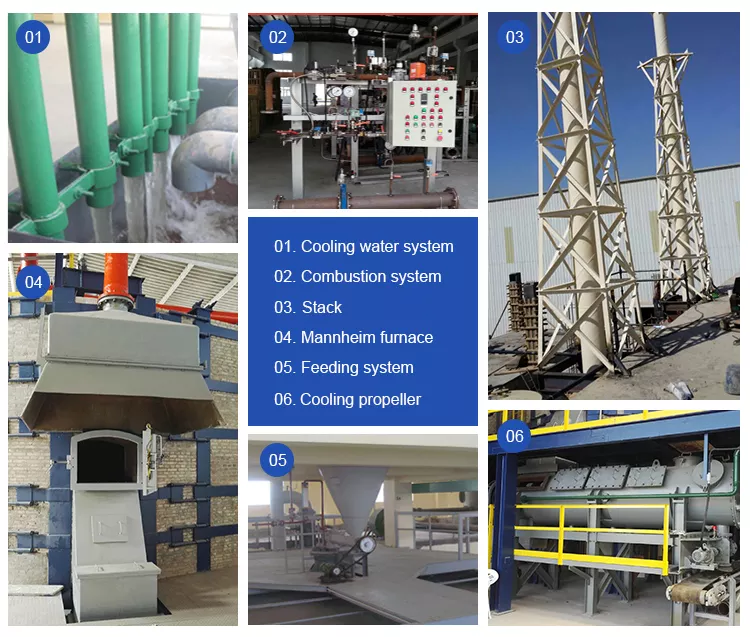Potassium Sulfate (SOP): A High-Value Alternative To Potassium Chloride (MOP)
In recent years, potassium sulfate (K 2 SO 4 ) has become the focus of the market with the growing population coupled with many other factors. Data Bridge Market Research estimates that the potassium sulfate market will grow at a CAGR of 5.5% from 2017 to 2024, reaching 10,535,840 tons by 2025. There is no doubt that the demand for potassium sulfate processing equipment is also on the rise.
Also known as potassium sulfate or SOP, potassium sulfate is a premium potash fertilizer that offers many benefits over the more commonly used potassium chloride (MOP).

Potassium Sulphate Plant with Mannheim Furnace
Benefits of Sulfate of Potash (SOP)
While potassium chloride (also known as KCl) is the most common potash fertilizer and is an excellent source of potassium and chloride, it is not suitable in all environments. As many have found, SOP not only improves yields and crop quality, but also offers many advantages.
Low salinity
Compared to most potash fertilizers, potassium sulfate has a low salt index, making it the preferred choice when soil salinity is a concern.
Chloride reduction
Chloride is an important component of MOP. While this is desirable for some crops, it can be detrimental to other crops that are sensitive to chloride, such as some fruits, vegetables and nuts. Many chloride-sensitive crops are high-value crops, so optimizing quality and yield is especially critical.
In addition, MOP can be toxic if added to soils already rich in chlorine. SOP offers the best solution when dealing with chlorine-sensitive crops or chlorine-rich soils because its chlorine content is greatly reduced.
Adding sulfur
In addition to potassium, potassium sulfate provides plant-available sulfur. In recent years, sulfur deficiencies have become increasingly common, making products containing secondary nutrients increasingly popular.
SOP PRODUCTION & EXTRACTION
Potassium sulfate (K2SO4) is not typically found as an existing compound in nature and therefore must be manufactured. There are two main approaches to obtaining SOP:
THE MANNHEIM PROCESS
Traditionally, SOP has been produced by the Mannheim process, in which KCl is reacted with sulfuric acid to yield K2SO4. Although this method does work, it produces the desired compound as a byproduct; the primary product resulting from the process is HCl.
This process consists of first carrying out an exothermic reaction between potassium chloride (KCl) and sulfuric acid (H2SO4), and then an endothermic reaction between potassium chloride (KCl) and potassium bisulfate (KHSO4) to produce HCl and K2SO4.
The resulting K2SO4 is cooled in a rotary cooler and may then be further finished into the desired product form.
While the Mannheim process is still in use, it has largely given way to an alternative method: extraction from natural complex salts.
COMPLEX SALT PROCESSING
Naturally existing complex salts can also provide a source of potassium sulfate. Here, potassium- and sulfate-bearing minerals are altered to remove byproducts, leaving potassium sulfate behind. This process is highly complex and contributes to the high cost of SOP.
A high-level overview of the process could be described as ore preparation and flotation, conversion to and leaching of schoenite, and finally, moisture reduction in a rotary dryer. This process may differ depending on the complex salt being treated.
Langbeinite, in particular, is a well known source of SOP that has gained popularity in recent years. This nutrient-rich mineral compounds (K2Mg2(SO4)3) can be modified to remove magnesium and obtain SOP, or it can be used as a potash fertilizer itself; in addition to potash and sulfur, langbeinite provides a source of secondary nutrient magnesium. For this reason, it is also known as sulfate of potash-magnesia, or SOPM. Kainite and carpathian polymineral ores are other common complex salts from which SOP is commonly derived.
Polyhalite, an evaporite mineral, is a similar source of SOP and magnesium. The mineral has been gaining interest in recent years, but is currently produced in only small quantities.
FORMS OF SOP
Potassium sulfate is like most potash fertilizers, in that it can be processed into a variety of different particle sizes and forms to meet various market needs; it is typically available in the form of powder, compaction granules, or round pellets/granules.
POWDERED POTASSIUM SULFATE
While powdered potassium sulfate provides fast nutrient delivery, it can be difficult to handle and transport, and often becomes windblown upon application. For this reason, it is often desirable to agglomerate SOP into one of the forms below.
COMPACTION GRANULES
Compaction granules are produced using a roll compactor, in which potassium sulfate is pressed into a sheet and then broken up into the desired size granules. This method makes the potassium sulfate much easier to handle with significantly reduced dust, but has jagged edges that are prone to breaking off into dust.
ROUND GRANULES
Spherical potassium sulfate granules are produced via a non-pressure agglomeration technique referred to as pelletizing. This is typically carried out on a disc pelletizer preceded by a pin mixer.
The granules produced in this process are of the highest quality, offering the least amount of dust and typically the greatest amount of flowability.
POTASSIUM SULFATE PROCESS DEVELOPMENT
Feasibility testing is an important aspect of developing a potassium sulfate fertilizer. Batch- and pilot-scale tests are used to gather process data and determine the best set of parameters to produce a product with the desired specifications from the unique source of material. Both roll compaction and pelletizing, along with drying can be evaluated.
A variety of particle characteristics can be measured and adjusted during testing to produce an agglomerate to exacting specifications. Target particle characteristics often include:
● Amount of attrition/degradation
● Bulk density
● Compression
● Crush strength
● Flowability
● Green/wet strength
● Moisture content
● Particle size analysis
● Physical characteristics
● Solubility
CONCLUSION
Potassium sulfate is a premium potash fertilizer offering a number of benefits over other potash fertilizers, including low chlorides, added sulfur, and reduced salinity. Produced through two primary approaches, SOP can be processed into powdered, granular, or spherical pellets. Testing is a critical component in the development of an SOP process, helping to gather process data necessary for scale-up.
With an extensive history in the fertilizer industry, DONGDING is a leader in custom equipment and systems for both traditional and novel fertilizer production, offering rotary dryers, coolers, disc pelletizers, pin mixers, and more. In addition to our custom equipment, we can provide comprehensive testing services at batch and pilot scale for the granulation of potassium sulfate into a product of desired specifications. For more information on our potassium sulfate capabilities, contact us today!




